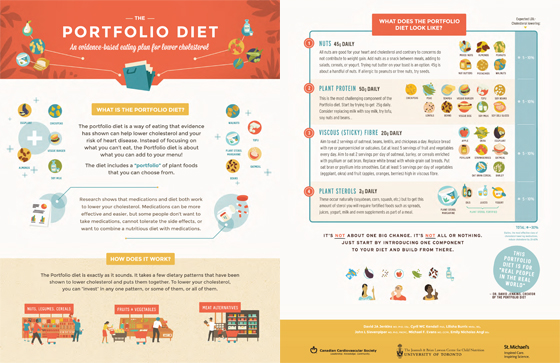The Portfolio Diet lowers cholesterol, inflammation and heart disease

By Mary Dickie

Drs. John Sievenpiper (left) and David Jenkins
We’ve all heard that a plant-based diet is good for us, but the theory that it can demonstrably lower cholesterol and decrease the risk of heart disease has been given new validation through an initiative developed by St. Michael’s staff physicians.
A meta-analysis and review of controlled trials led by Dr. John Sievenpiper and published in Progress in Cardiovascular Diseases found that the Portfolio Diet, which includes plant proteins like tofu and beans, viscous fibre, nuts and plant sterols instead of saturated fats, can lower blood cholesterol as much as statins, the widely prescribed drugs that work by inhibiting an enzyme the body uses to produce cholesterol.
Developed by Dr. David Jenkins, the Portfolio provides other benefits as well, including improving blood pressure and glucose metabolism, decreasing inflammation and reducing the 10-year risk of heart disease by 13 per cent.
“Not everyone can take a statin,” Dr. Jenkins explains. “As much as 10% of the population gets muscle pain, and there is a small but measurable risk of diabetes. So I think the dietary approach is important, especially given the effects on blood pressure and glucose metabolism.”
“That’s the beauty of diet over medication — you can impact a lot of different risk factors at the same time,” says Dr. Sievenpiper.
Each of the four elements in the Portfolio has Health Canada or FDA approved claims to reduce blood cholesterol by 5% to 10%. Dr. Jenkins decided to see if taking them all would create an additive effect. “No one had really asked that question before,” says Dr. Sievenpiper. “We pooled all the available trials, and we were able to verify that when it’s combined with a low saturated fat diet, we do see a reduction of 30%, which is similar to what you see with statins.”
Dr. Jenkins labelled it the Portfolio Diet and the duo worked with a designer on an infographic that provides food options and recommended amounts. Patients can see benefits when they invest in one or all of its components —instead of or in addition to taking statins.
“It’s not an all-or-nothing diet, it’s incremental,” says Dr. Sievenpiper. “So I will say, ‘Today, let’s just work on getting some viscous fibre by having a bowl of oats in the morning.’ The next time, we’ll talk about adding tofu and beans, and then nuts and maybe plant sterols. The more you do, the greater the benefits.”
“That’s the brilliant touch — make it simple, write it on a prescription pad and give it to the patient,” says Dr. Jenkins. “That’s John’s quantum leap to put it into clinical practice. John also sits on the guidelines committee for the Canadian Cardiovascular Society, so what he does on his prescription pad becomes relevant to everyone in Canada.” And not only Canada: both Heart UK and the European Atherosclerosis Society have adopted the Portfolio recommendations.
Sheila MacLaren, a patient who began the Portfolio diet in 2002 after being diagnosed with high cholesterol, says that switching to vegetable proteins was difficult at first. “I’m a meat lover!” she says. “I had a friend staying with me at the time, and I complained and complained, and she said, ‘The trouble with you is that you have no self-discipline.’ I was so furious that I did not take one mouthful of anything other than what I supposed to for a month. And my cholesterol really dropped!”
McLaren is still following the diet.” I’ve refined it over the years,” she says. “I make soup with vegetables and beans, and I take the viscous fibre before meals and feel full. My cholesterol isn’t at the all-time low, but it’s in the range of 3. And I’ve lost 50 pounds!”
Dr. Sievenpiper and Dr. Jenkins are now conducting a five-year study they call the Enhanced Portfolio. “We’re running a trial across Canada, looking at the Portfolio and what it does to arterial damage using MRIs and ECGs,” says Dr. Jenkins. “It’s a diet study with all the rigour you get in a drug study. The whole point is that it’s close to the pharmacologic approach.”
“It adds healthy oils to further improve the lipid profile, exercise, and low glycemic index carbohydrates to further improve the metabolic profile,” adds Dr. Sievenpiper. “And when we put all those things together, we’re hoping it’ll have a profound impact on arterial damage. That’s our hypothesis.”

View a larger version of this infographic, as well as a text version.
About St. Michael’s Hospital
St. Michael’s Hospital provides compassionate care to all who enter its doors. The hospital also provides outstanding medical education to future health care professionals in more than 29 academic disciplines. Critical care and trauma, heart disease, neurosurgery, diabetes, cancer care, care of the homeless and global health are among the Hospital’s recognized areas of expertise. Through the Keenan Research Centre and the Li Ka Shing International Healthcare Education Centre, which make up the Li Ka Shing Knowledge Institute, research and education at St. Michael’s Hospital are recognized and make an impact around the world. Founded in 1892, the hospital is fully affiliated with the University of Toronto.
